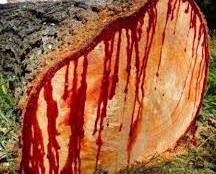Dragon blood-oozing Tree discovered in Assam

India´s first Dragon blood-oozing Tree discovered in Assam. The Dragon blood-oozing Tree is a bright red resin used since ancient times as medicine, body oil, varnish, incense and dye. A trio of researchers led by Assam forest officer Jatindra Sarma has discovered Dracaena cambodiana, a dragon tree species in the Dongka Sarpo area of West Karbi Anglong. The team’s report has been published in the latest issue of the Journal of the Botanical Research Institute of Texas.
Daily Current Affairs Quiz 2019
This is for the first time that a Dragon blood-oozing Tree species has been reported from India.
“We found the Dragon blood-oozing Tree species on hilly rock crevices within a 0.05 sq km area. It took us four years of fieldwork and study to classify the plant as a dragon tree species whose sap turns bright red after coming in contact with air,” Mr. Sarma, Northern Assam Circle’s Chief Conservator of Forests told The Hindu on Tuesday.
The report has been co-authored by Hussain Ahmed Barbhuiya of Bhabha Atomic Research Centre and Santanu Dey of Nagaland University’s Department of Botany.
In India, the Dracaena genus belonging to the family Asparagaceae is represented by nine species and two varieties in the Himalayan region, the northeast and Andaman and Nicobar Islands. But Dracaena cambodiana is the only true dragon tree species, the study said.
Dracaena cambodiana is an important medicinal plant as well as an ornamental tree. it is a major source of dragon’s blood, a precious traditional medicine in China. Several antifungal and antibacterial compounds, antioxidants, flavonoids, etc., have been extracted from various parts of the plant.
“Recent overexploitation to meet the increasing demand for dragon’s blood has resulted in rapid depletion of the plant. For this reason, the species is already listed in the inventory of Rare and Endangered Plants of China,” Mr Sarma said.
The population size of the dragon tree species in Assam was estimated to be fewer than 50 mature individuals. “The habitat of the plant is severely fragmented due to open excavation of a stone quarry and there is continuing decrease in its area of occupancy and number of mature individuals,” he said.
The Dracaena seeds are usually dispersed by birds. But due to the large fruit size, only a few species of birds are able to swallow the fruits, thus limiting the scope of its natural conservation. The study advocates conservation programme for Dracaena cambodiana in view of its medicinal, ornamental and ecological values.